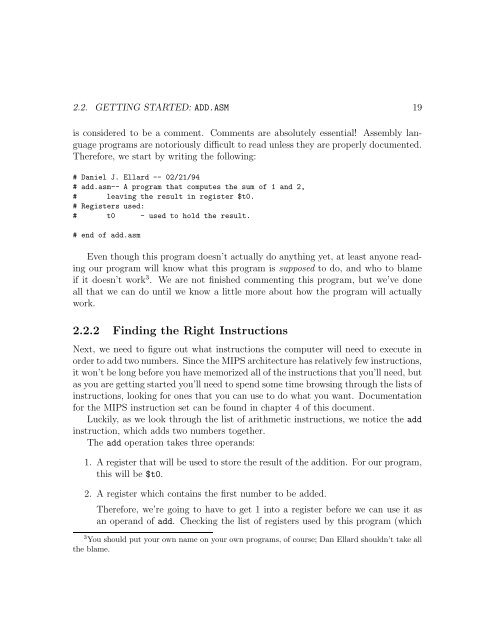MIPS Assembly Language Programming
MIPS Assembly Language Programming
MIPS Assembly Language Programming
Create successful ePaper yourself
Turn your PDF publications into a flip-book with our unique Google optimized e-Paper software.
2.2. GETTING STARTED: ADD.ASM 19<br />
is considered to be a comment. Comments are absolutely essential! <strong>Assembly</strong> language<br />
programs are notoriously difficult to read unless they are properly documented.<br />
Therefore, we start by writing the following:<br />
# Daniel J. Ellard -- 02/21/94<br />
# add.asm-- A program that computes the sum of 1 and 2,<br />
# leaving the result in register $t0.<br />
# Registers used:<br />
# t0 - used to hold the result.<br />
# end of add.asm<br />
Even though this program doesn’t actually do anything yet, at least anyone reading<br />
our program will know what this program is supposed to do, and who to blame<br />
if it doesn’t work 3 . We are not finished commenting this program, but we’ve done<br />
all that we can do until we know a little more about how the program will actually<br />
work.<br />
2.2.2 Finding the Right Instructions<br />
Next, we need to figure out what instructions the computer will need to execute in<br />
order to add two numbers. Since the <strong>MIPS</strong> architecture has relatively few instructions,<br />
it won’t be long before you have memorized all of the instructions that you’ll need, but<br />
as you are getting started you’ll need to spend some time browsing through the lists of<br />
instructions, looking for ones that you can use to do what you want. Documentation<br />
for the <strong>MIPS</strong> instruction set can be found in chapter 4 of this document.<br />
Luckily, as we look through the list of arithmetic instructions, we notice the add<br />
instruction, which adds two numbers together.<br />
The add operation takes three operands:<br />
1. A register that will be used to store the result of the addition. For our program,<br />
this will be $t0.<br />
2. A register which contains the first number to be added.<br />
Therefore, we’re going to have to get 1 into a register before we can use it as<br />
an operand of add. Checking the list of registers used by this program (which<br />
3 You should put your own name on your own programs, of course; Dan Ellard shouldn’t take all<br />
the blame.

















